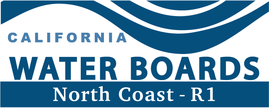TMDL Development
The Clean Water Act states that each state shall establish, for impaired waterbodies as listed on the 303(d) list, and in accordance with a priority ranking, the total maximum daily load for the pollutant of concern (33 USC §1313). In other words, for waterbodies on the 303(d) list, states, territories, and authorized tribes must develop TMDLs that will achieve water quality standards, allowing for seasonal variations and an appropriate margin of safety.
TMDLs should address all significant stressors which cause or threaten to cause waterbody use impairment. Within the North Coast Region the stressors of concern are sediment, temperature, nutrients, low dissolved oxygen, turbidity, and mercury. Many of the beneficial use impairments are associated with the cold water salmonid fishery.
The specific components of a TMDL are as follows:
* Problem Statement. The problem statement provides a description of the existing in-stream and upslope watershed setting and the beneficial uses impairments of concern.
* Numeric Targets. Numeric targets are based on and implement the water quality objectives adopted in the Basin Plan. Numeric targets provide indicators of watershed health and express the desired future condition for each stressor addressed in a TMDL. Numeric targets are goals, not requirements. They provide a guidepost to landowners, resource managers, and the public by which to determine how close the TMDL is to re-creating an in-stream environment suitable of supporting beneficial uses, i.e., sustainable populations of salmonids. They are not expected to be attained immediately, nor are they directly enforceable.
* Source Analysis. Point, non-point, and background sources of pollutants of concern, as well as their magnitude and location, are described in the source analysis. In short, the source analysis describes where the pollution is coming from.
* Loading Capacity. The loading capacity of a watershed is an estimate of how much pollution can reach the waterbody without impairing beneficial uses. The loading capacity can be determined by estimating historic loading, estimating loading to a reference stream, or modeling a watershed's dynamics under a scenario in which desired habitat conditions exist.
* Load Allocation. The load allocation is an estimate of the portions of the watershed's loading capacity that are attributed to the different pollutant sources within the watershed. In short, the sum of the load allocations equals the loading capacity. Load allocations can be estimated for each of the different land use activities in a watershed. For example, sediment discharges can be expressed as tons per square mile per year, percent reduction, ratio of controllable versus natural load, or other appropriate measure.
* Margin of Safety & Seasonal Variations. The margin of safety summarizes the qualitative and quantitative means by which the final load allocations account for any uncertainty in the data or data analysis. The seasonal variation section summarizes the changes which may vary in different years and at different times of the year (i.e., the discharges of sediment, increases of temperature, and their associated effects on beneficial uses), and how the variations are addressed in the TMDL.
Resources
TMDL Projects
- Albion River
- Big River
- Coastal Pathogens
- Eel River, North Fork
- Eel River, Upper Main
- Eel River, Middle Main
- Eel River, Middle Fork
- Eel River, Lower Main
- Eel River, South Fork
- Elk River
- Freshwater Creek
- Garcia River
- Gualala River
- Klamath River
- Laguna De Santa Rosa
- Lost River, Upper
- Lost River, Lower
- Mad River
- Mattole River
- Navarro River
- Noyo River
- Redwood Creek
- Russian River
- Salmon River
- Scott River
- Shasta River
- Stemple Creek
- Ten Mile River
- Trinity River
- Trinity River, South Fork
- Van Duzen River
(Page last updated 8/24/17)
Water is a precious resource in California, and maintaining its quality is of utmost importance to safeguard the health of the public and the environment.
Statewide Campaigns
EPA Water Sense
File an Environmental Complaint
Save Our Water
Flex Alert
Register to Vote



